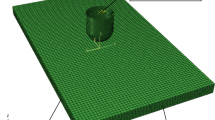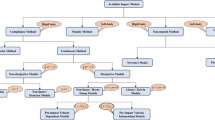Abstract
The major focus of this investigation is to analyze the effect of the time step scale factor (TSSFAC) parameter value on the numerical simulation results obtained by LS-DYNA for glass fiber reinforced polymer (GFRP) composite laminates subjected to low velocity impact. The TSSFAC is a parameter in the CONTROL_TIMESTEP keycard. The numerical simulations are conducted for two impact velocities 1.5 m/s and 4 m/s. At 1.5 m/s impact velocity, the impactor rebounded, whereas at an impact velocity 4 m/s, the impactor perforated the GFRP composite laminate. The TSSFAC values considered for the numerical simulation are 0.001, 0.01, 0.1, 0.5, 0.6, 0.7, and 0.9. The TSSFAC values affected both numerical simulation accuracy and numerical simulation time. However, the extent of influence of TSSFAC is high for simulation time compared to the numerical simulation accuracy. The simulation time increased as the TSSFAC value decreased. It was found that the TSSFAC value 0.6 yielded minimum simulation time compared to other TSSFAC values. Further, the best correlation between experimental and simulation results is found for 0.6 TSSFAC value.
Access this chapter
Tax calculation will be finalised at checkout
Purchases are for personal use only
Similar content being viewed by others
References
Singh KK, Shindhe M (2022) Introduction to fibre reinforced polymer composite laminates. In: Singh KK, Shinde M (eds) Impact behavior of fibre reinforced laminates: fundamentals of low velocity impact and related literature on FRP. Springer Singapore, Singapore, pp 1–43. https://doi.org/10.1007/978-981-16-9439-4_1
Singh KK, Shindhe M (2022) Low velocity impact on fibre reinforced polymer composite laminates. In: Impact behavior of fibre reinforced laminates: fundamentals of low velocity impact and related literature on FRP. Springer Singapore, Singapore, pp 83–105. https://doi.org/10.1007/978-981-16-9439-4_3
Singh KK, Shindhe M (2022) Numerical analysis of low velocity impact and compression after impact on fibre reinforced composite laminates. In: Singh KK, Shinde M (eds) Impact behavior of fibre reinforced laminates: fundamentals of low velocity impact and related literature on FRP. Springer Singapore, Singapore, pp 265–302. https://doi.org/10.1007/978-981-16-9439-4_9
Rawat P, Singh NK, Singh KK, Agrhari N (2019) Influence of oblique impact on glass fiber-reinforced polymer composites: a numerical approach. In: Singh I, Bajpai PK, Panwar K (eds) Trends in materials engineering. Springer Singapore, Singapore, pp 77–86. https://doi.org/10.1007/978-981-13-9016-6_9
Rawat P, Singh NK, Singh KK, Kumar A (n.d.) Experimental and numerical approach to investigate damage tolerance in FRP composites subjected to transverse low-velocity impact
Rawat P, Singh KK, Singh NK (2017) Numerical investigation of damage area due to different shape of impactors at low velocity impact of GFRP laminate. Mater Today Proc 4:8731–8738. https://doi.org/10.1016/j.matpr.2017.07.222
Rawat P, Singh KK, Singh NK (2017) Numerical investigation of low-velocity impact in symmetric and asymmetric GFRP laminate with and without pre-crack. Adv Mater Proc 2:152–155. https://doi.org/10.5185/amp.2017/304
Mahesh, Singh KK (2020) In-plane low velocity impact behavior of GFRP laminate. In: Materials science forum. Trans Tech Publication, pp 257–263. https://doi.org/10.4028/www.scientific.net/MSF.978.257
Mahesh, Singh KK (2019) Influence of varying fully constrained circular boundary condition area on damage mechanism of GFRP laminate under low velocity impact loading. In: Narayanan RG, Joshi SN, Dixit US (eds) Advances in computational methods in manufacturing. Springer Singapore, Singapore, pp 1011–1021. https://doi.org/10.1007/978-981-32-9072-3_85
Mahesh, Singh KK (2019) Numerical simulation of GFRP laminate under low-velocity impact at different edge-constrained boundary conditions. In: Singh I, Bajpai PK, Panwar K (eds) Trends in materials engineering. Springer Singapore, Singapore, pp 87–95. https://doi.org/10.1007/978-981-13-9016-6_10
Menna C, Asprone D, Caprino G, Lopresto V, Prota A (2011) Numerical simulation of impact tests on GFRP composite laminates. Int J Impact Eng 38:677–685. https://doi.org/10.1016/J.IJIMPENG.2011.03.003
Fragassa C, Vannucchi de Camargo F, Pavlovic A, Minak G (2019) Explicit numerical modeling assessment of basalt reinforced composites for low-velocity impact. Compos Part B Eng 163:522–535. https://doi.org/10.1016/j.compositesb.2019.01.013
Andrew JJ, Srinivasan SM, Arockiarajan A, Dhakal HN (2019) Parameters influencing the impact response of fiber-reinforced polymer matrix composite materials: a critical review. Compos Struct 224:111007. https://doi.org/10.1016/j.compstruct.2019.111007
Bogenfeld R, Kreikemeier J, Wille T (2018) Review and benchmark study on the analysis of low-velocity impact on composite laminates. Eng Fail Anal 86:72–99. https://doi.org/10.1016/j.engfailanal.2017.12.019
Rawat P, Singh KK (2017) An impact behavior analysis of CNT-based fiber reinforced composites validated by LS-DYNA: a review. Polym Compos 38:175–184. https://doi.org/10.1002/pc.23573
Singh NK, Singh KK (2015) Review on impact analysis of FRP composites validated by LS-DYNA. Polym Compos 36:1786–1798. https://doi.org/10.1002/pc.23064
Singh KK (2022) Mahesh, Effect of ply position switching in quasi-isotropic glass fibre reinforced polymer composite subjected to low velocity impact. Int J Damage Mech 31:665–693. https://doi.org/10.1177/10567895211068176
Rabiee A, Ghasemnejad H (2022) Finite element modelling approach for progressive crushing of composite tubular absorbers in LS-DYNA: review and findings. J Compos Sci 6. https://doi.org/10.3390/jcs6010011
Author information
Authors and Affiliations
Corresponding author
Editor information
Editors and Affiliations
Rights and permissions
Copyright information
© 2024 The Author(s), under exclusive license to Springer Nature Singapore Pte Ltd.
About this paper
Cite this paper
Mahesh, Kumar, S., Singh, K.K., Rawat, P. (2024). Effect of Time Step Scale Factor Value on the Low Velocity Impact Numerical Simulation Results in LS-DYNA. In: Velmurugan, R., Balaganesan, G., Kakur, N., Kanny, K. (eds) Dynamic Behavior of Soft and Hard Materials Volume 1. IMPLAST 2022. Springer Proceedings in Materials, vol 34. Springer, Singapore. https://doi.org/10.1007/978-981-99-6030-9_45
Download citation
DOI: https://doi.org/10.1007/978-981-99-6030-9_45
Published:
Publisher Name: Springer, Singapore
Print ISBN: 978-981-99-6029-3
Online ISBN: 978-981-99-6030-9
eBook Packages: Chemistry and Materials ScienceChemistry and Material Science (R0)




